Origin Genesis Review: Triple Titan Terror
by Ryan Smith on April 23, 2013 9:00 AM ESTApplication and Futuremark Performance
Though our Genesis system is primarily intended for gaming, with gaming being such a resource-intensive hobby it tends to follow that the Genesis is also an incredibly high performer at virtually everything else. The 4.9GHz SNB-E processor is as fast as they come right now, and with the triple Titans and RAID-0 SSDs backing it up, it’s clear there are very few computers that will come anywhere close to the Genesis.
As such our standard application and Futuremark benchmarks are here mostly because they’re obligatory. We simply haven’t reviewed any prior systems, even other SNB-E systems, that are as powerful as the Genesis. It takes the top spot in everything.
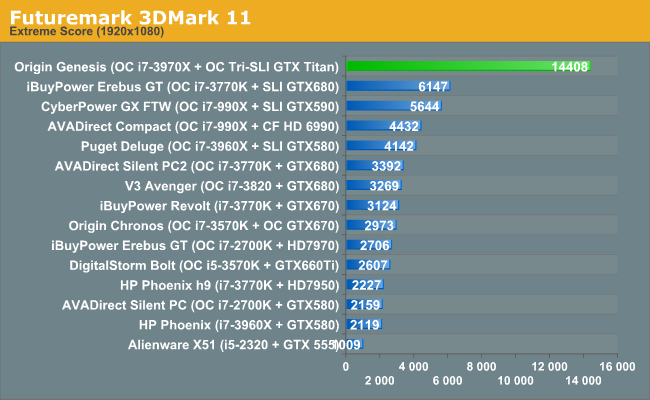

The Genesis more than doubles the 3DMark performance of the next-fastest system we’ve reviewed, an overclocked IVB + GTX 680 SLI configuration. Meanwhile the PCMark scores are much closer since most of the PCMark score is determined by CPU and storage performance rather than GPU performance, but thanks to the hefty overclock on its i7-3970X processor, the Genesis is still almost 700 points ahead of the next-closest system.
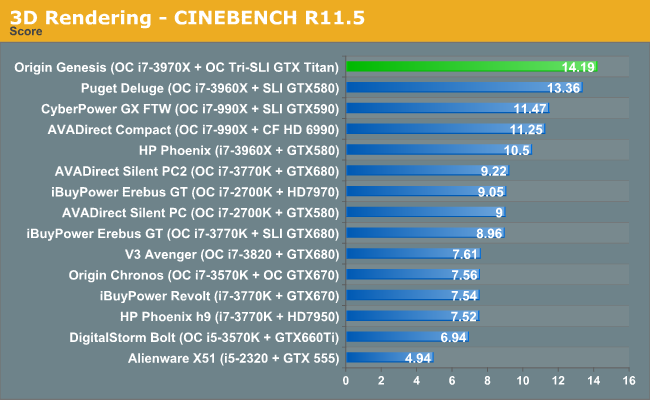
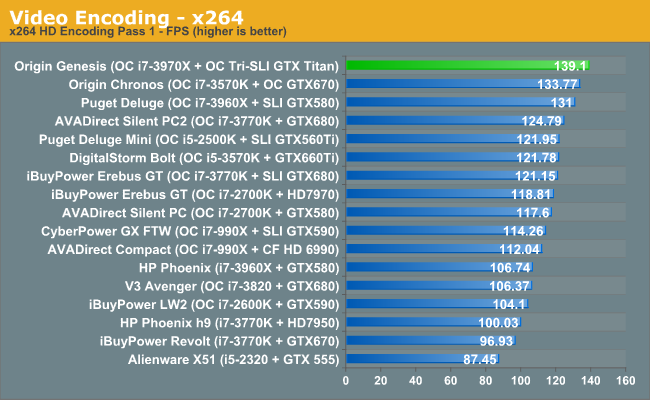
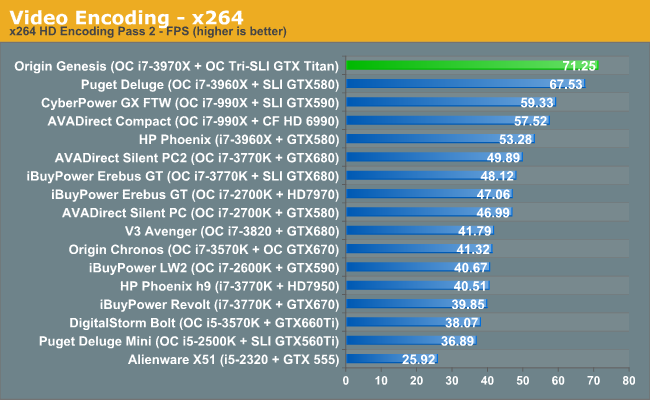
Diving into our CPU-dependent benchmarks, the story is much the same. Thanks to the CPU overclock, the 4.9GHz SNB-E processor means the Genesis pushes past even other SNB-E systems in both Cinebench and x264 encoding. At this point the Genesis is approaching the limit for what any kind of single-socket consumer system is going to be able to achieve.
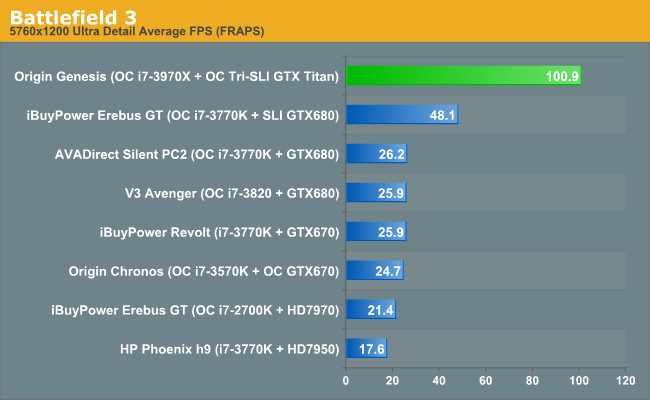
Finally, we’re throwing in one of our standard gaming benchmarks before going into tri-SLI Titan’s performance in-depth. Even at 5760x1200 with Ultra settings, Battlefield 3 is hard-pressed to keep 3 Titan cards occupied, with the Genesis delivering 100fps. 3D Surround BF3, anyone?










63 Comments
View All Comments
shadowofthesun - Tuesday, April 23, 2013 - link
Gotta agree with this- I ended up ditching my HDMI via nVidia setup because it worked extremely poorly in Linux and even in Windows would fail to initialize my HDMI output as an audio device if the screen went to sleep. Luckily the optical out works fine.viliu - Tuesday, April 30, 2013 - link
meh, the same as a Ferrari, it's obviously quick, but noisy, hot and draws a hell of a lot of fuel.But i'l bet ur lick ur back side for one of those... Anyway, there are always beautiful things for car/boats/computers and whatever enthusiasts .I will definitely want one of those, even if i already have a nice car and a good computer, but as human i will always want more and never will be happy whit whatever i have nowwingless - Tuesday, April 23, 2013 - link
Can I finally play a game with triple monitors in 3D on this machine? Barely; Still this is an amazing machine, especially for those in cold climates. I like it!APassingMe - Tuesday, April 23, 2013 - link
Thanks for the great review, it reminds me of all the reasons why I still read AnandTech after all these years.However, could you please run your reviews through a good third party for a quality check? It really is distracting to read through the review and have to pause and think.... what's missing here... Oh, it's just that "of" is left off or something similar, I know it slows down the overall release of the review but please consider it.
Thanks.
-APassingMe
geniekid - Tuesday, April 23, 2013 - link
I feel like the whole point of liquid cooling is to shunt heat to a radiator which is then cooled by a low flow fan. Why then do you need 13 million (possible exaggeration) case fans?A5 - Tuesday, April 23, 2013 - link
There are two reasons to watercool:1) Reduce noise and maximize cooling on modest machines
2) Maximize cooling to reach insane performance heights.
This system is firmly in the second camp. It simply wouldn't be possible to run it at these clocks on air cooling.
A5 - Tuesday, April 23, 2013 - link
Also, in this case, each case fan slot is actually a radiator with 2+ fans on it.DanNeely - Tuesday, April 23, 2013 - link
If it was a more modest setup you wouldn't; but this system has a heavy overclocked CPU and 4 heavily overclocked GPUs; which means it's trying to dump close to 1200W through the radiators. In a more mainstream system you'd have ~80-150W from the CPU and 150-300W from the GPU. In that case a single 3x120 rad with one set of fans (vs push pull) would probably be adequate, and be much quieter under load than the GPUs blower.justaviking - Tuesday, April 23, 2013 - link
Compute performance? I was curious what sort of compute performance you'd get with 3 Titans. Did I just miss that? Of course, it doesn't really matter. I did not find $9k in my pocket this morning. But it would still be interesting to see.colinstu - Tuesday, April 23, 2013 - link
Hope 6-8 years from now this same amount of power can be had in the space of a small matx case and for $600-1200. But then again... just imagine how the games will be (or won't be) by then.